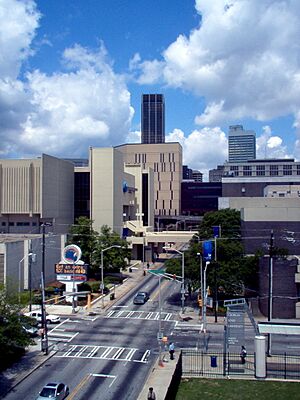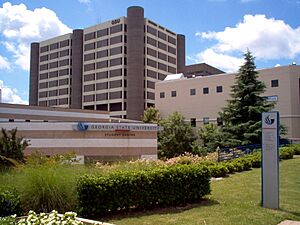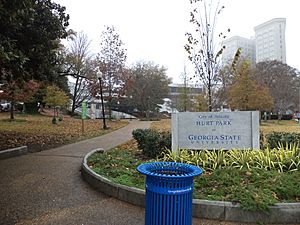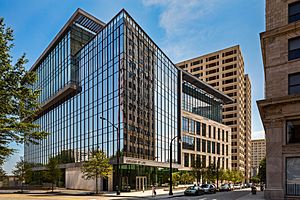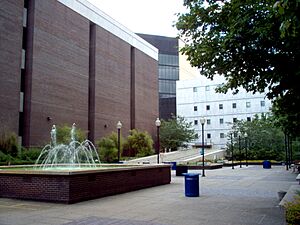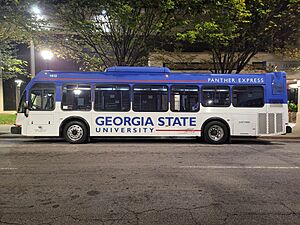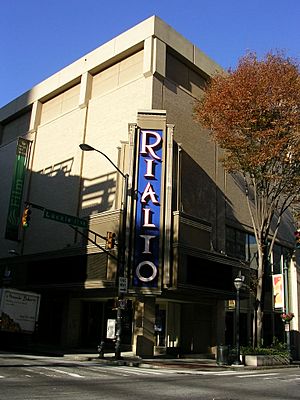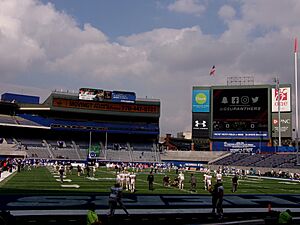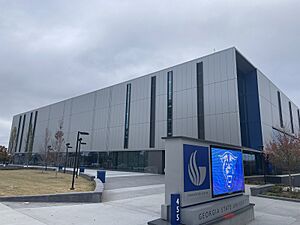Georgia State University facts for kids
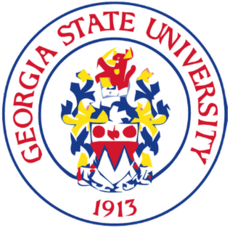 |
|
|
Former names
|
Evening School of Commerce of Georgia Institute of Technology (1913–1947) Atlanta Division of the University of Georgia (1947–1955) Georgia State College of Business Administration (1955–1961) Georgia State College (1961–1969) DeKalb College (1964–1972) DeKalb Community College (1972–1997) Georgia Perimeter College (1997–2016) |
|---|---|
| Motto | Veritas valet et vincet (Latin) |
|
Motto in English
|
"Truth shall overcome" |
| Type | Public research university |
| Established | 1913 |
|
Parent institution
|
University System of Georgia |
| Accreditation | SACS |
|
Academic affiliations
|
|
| Endowment | $170.8 million (2020) |
| Budget | $1.149 billion (2020) |
| President | M. Brian Blake |
| Provost | Nicolle Parsons-Pollard |
|
Academic staff
|
1,586 (fall 2018) |
|
Administrative staff
|
3,627 (fall 2018) |
| Students | 50,521 (fall 2023) |
| Undergraduates | 43,807 (fall 2023) |
| Postgraduates | 6,714 (fall 2023) |
| 1,971 (fall 2023) | |
| Location |
,
,
United States
33°45′13.3″N 84°23′09.5″W / 33.753694°N 84.385972°W |
| Campus | Large city, 109.87 acres (0.445 km2) (main campus); 440.06 acres (1.781 km2) (all instructional sites); 771.41 acres (3.122 km2) (total) |
| Radio station | WRAS |
| Newspaper | The Signal |
| Colors | Blue and white |
| Nickname | Panthers |
|
Sporting affiliations
|
|
| Mascot | Pounce the Blue Panther |
| Other campuses | |
| Website | gsu.edu |
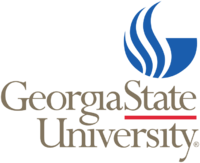 |
|
Georgia State University (often called Georgia State, State, or GSU) is a big public university in Atlanta, Georgia, United States. It was started in 1913. It's one of the four main research universities in the University System of Georgia. With about 50,000 students, it's the second-largest university in Georgia. About 33,000 students study at the main campus in Downtown Atlanta.
Georgia State is known as an "R1: Doctoral University." This means it does a lot of research and offers many advanced degrees. The university has over 250 different degree programs in more than 100 subjects. These programs are spread across 10 colleges and schools. Georgia State has two main libraries. The University Library is split between two buildings on the main campus. It also has branches at the Perimeter College campuses. The Law Library is on the main campus. Together, these libraries have over 13 million items. Georgia State helps Georgia's economy by about $2.5 billion.
Georgia State University's sports teams are called the Georgia State Panthers. They compete in NCAA Division I in the Sun Belt Conference. Georgia State was one of the first members of the Sun Belt Conference.
Contents
History of Georgia State
Georgia State University began in 1913 as a night school. It was first called the Evening School of Commerce of the Georgia Institute of Technology. In the 1930s, it became part of the University System of Georgia. This allowed night students to earn degrees from different colleges.
In 1947, the school joined the University of Georgia. It was then called the Atlanta Division of the University of Georgia. For its first 40 years, it was like a branch of other universities. In 1955, it became its own four-year college. It was named Georgia State College of Business Administration. Walter Sparks, who had led the school since 1927, became its first president. In 1961, the name was shortened to Georgia State College. It officially became Georgia State University in 1969.
In 1962, the first African-American student enrolled at Georgia State. Her name was Annette Lucille Hall. She was a social studies teacher from Lithonia.
In 1995, Georgia State was given "research university" status. This put it in the same group as the University of Georgia and Georgia Institute of Technology.
Campus Growth Over Time
Early Expansion: 1913–1975
Georgia State has grown a lot over its 100-year history. It needed more space as it got bigger. In the late 1960s and early 1970s, many buildings were built. These included the Pullen Library in 1966 and the Sports Arena in 1973. A system of raised walkways was also built. These walkways connected buildings over Decatur Street.
More Buildings Added: 1980–1989
In the 1980s, the university grew again. It bought the old Atlanta Municipal Auditorium in 1979. This building became Dahlberg Hall in 2010. It now holds Georgia State's main offices. The College of Law started in 1982. A new Library South building was built in 1988. It connected to the Pullen Library, doubling the library's size.
Growth Continues: 1990–2004
Georgia State kept growing in the 1990s. The Natural Science Center opened in 1992. The former C&S Bank Building became the J. Mack Robinson College of Business in 1993. The university also moved into the Fairlie-Poplar area. It bought and fixed up the Rialto Theater in 1996. This theater is now home to Georgia State's Jazz Studies program. A new Student Recreation Center opened in 2001. In 2004, the Andrew Young School of Policy Studies moved to the former Wachovia Bank Building.
Modern Expansion: 2005–2015
After 2006, many new buildings were added. The Pullen Library was updated. New student housing was built, like the University Commons in 2007. Freshman Hall (now Patton Hall) opened in 2009. Two hotels were turned into a new dorm called Piedmont North. The Parker H. Petit Science Center was finished in 2010. In 2013, Georgia State started using the 25 Park Place Building. This tall building houses many academic offices. In 2015, the College of Law moved to its new building.
Recent Developments: 2016–Present
An extension to the Petit Science Center was finished in 2016. The university also made plans to improve its sports facilities. In 2014, Georgia State announced it wanted to buy the Turner Field site. This was after the Atlanta Braves baseball team moved to a new stadium. The university planned to turn Turner Field into a football stadium. It also planned to build a new baseball field and student housing.
On December 21, 2015, Georgia State's plan for Turner Field was accepted. The purchase was completed on January 5, 2017. The stadium was renamed Georgia State Stadium and later Center Parc Stadium. It hosted its first football game on August 31, 2017.
In June 2021, M. Brian Blake became Georgia State University's first African-American president. In November 2024, the university received $107 million for campus upgrades. This included a large donation from the Robert W. Woodruff Foundation.
Joining with Georgia Perimeter College
On January 5, 2015, Georgia State and Georgia Perimeter College decided to merge. Georgia Perimeter College was a two-year college with five campuses. The merger was approved in 2016. The combined university kept the name Georgia State University. This made it the largest university in Georgia, with about 52,000 students. Since the merger, graduation rates at Perimeter College have almost tripled.
Campus Life and Buildings
Georgia State University is located right in the middle of Downtown Atlanta. The university has embraced its city location. Its slogan is "a part of the city, not apart from the city."
Key Campus Buildings
25 Park Place
25 Park Place is a large building with classrooms and offices. It used to be the SunTrust Bank Building. Georgia State University bought it in 2006.
Sparks Hall
Sparks Hall was the first building made just for Georgia State. It opened in 1955. In 1960, it was named after George McIntosh Sparks, a former president. Today, it holds admissions offices, financial services, classrooms, and computer labs.
Student Housing
After the 1996 Summer Olympics in Atlanta, Georgia State got its first dorms. These were part of the Olympic Village.
University Lofts
The University Lofts opened in 2002. It has 550 beds for undergraduate students and student-athletes. It also houses students with families and graduate students.
University Commons
The University Commons opened in 2007. This large complex houses nearly 2,000 students. It was voted one of the "best overall dorms in the country" in 2011.
Patton Hall
In 2009, Georgia State opened Patton Hall. This dorm is just for first-year students. It has a dining hall that serves buffet-style meals.
Greek Housing
In 2010, Georgia State opened special housing for its Greek organizations (fraternities and sororities).
Piedmont North
Georgia State bought two hotels and turned them into dorms called Piedmont North. These dorms house about 1,100 students. They also have green spaces and a large dining hall.
Piedmont Central
Piedmont Central is a new residence hall that opened in 2016. It has 1,152 beds and a large dining facility.

Campus Safety
The university has its own police department. It has over 160 police officers and many security guards. This makes it the largest campus law enforcement agency in Georgia.
Perimeter College Campuses
Perimeter College has five campuses around the Metro Atlanta area. These are in Alpharetta, Clarkston, Decatur, Dunwoody, and Newton County. Each campus offers different facilities like athletic fields, greenhouses, and student centers.
Academics and Research
| ARWU World | 501–600 |
|---|---|
| THES World | 501–600 |
| USNWR National University | 196 |
| Washington Monthly National University | 156 |
| Forbes | 513 |
| U.S. News University Rankings | |||
|---|---|---|---|
| Category | Ranking | ||
| National Universities | 197 | ||
| Best Undergraduate Teaching | 3 | ||
| Most Innovative Schools | 2 | ||
| Top Performers on Social Mobility | 8 | ||
| Top Public Schools | 101 | ||
| Business: Insurance | 4 | ||
| Business: Management Information Systems | 10 | ||
| Business: Real Estate | 11 | ||
| First-Year Experiences | 5 | ||
| Learning Communities | 5 | ||
| U.S. News Graduate School Rankings | |||
|---|---|---|---|
| Program | Ranking | ||
| Biological Sciences | 140 | ||
| Business: Information Systems | 13 | ||
| Business: Part-time MBA | 48 | ||
| Chemistry | 114 | ||
| Clinical Psychology | 62 | ||
| Criminology | 22 | ||
| Economics | 59 | ||
| Education | 45 | ||
| Education: Best Online Master's in Education Programs | 35 | ||
| Education: Curriculum and Instruction | 23 | ||
| Education: Elementary Teacher Education | 21 | ||
| Education: Secondary Teacher Education | 22 | ||
| Education: Student Counseling and Personnel Services | 11 | ||
| English | 99 | ||
| Fine Arts | 131 | ||
| Health Care Management | 39 | ||
| History | 125 | ||
| Law | 67 | ||
| Law: Clinical Training | 26 | ||
| Law: Dispute Resolution | 44 | ||
| Law: Environmental Law | 103 | ||
| Law: Health Care Law | 1 | ||
| Law: International Law | 78 | ||
| Law: Legal Writing | 75 | ||
| Law: Part-time Law | 13 | ||
| Law: Tax Law | 43 | ||
| Law: Trial Advocacy | 21 | ||
| Mathematics | 136 | ||
| Nursing: Doctor of Nursing Practice | 126 | ||
| Nursing: Master's | 99 | ||
| Physical Therapy | 71 | ||
| Physics | 110 | ||
| Political Science | 72 | ||
| Psychology | 112 | ||
| Public Affairs | 21 | ||
| Public Affairs: Local Government Management | 7 | ||
| Public Affairs: Nonprofit Management | 9 | ||
| Public Affairs: Public Finance and Budgeting | 8 | ||
| Public Affairs: Public Management and Leadership | 19 | ||
| Public Affairs: Public Policy Analysis | 22 | ||
| Public Affairs: Urban Policy | 8 | ||
| Public Health | 56 | ||
| Rehabilitation Counseling | 55 | ||
| Social Work | 59 | ||
| Sociology | 71 | ||
| Speech-Language Pathology | 53 | ||
| U.S. News Global Rankings | |||
|---|---|---|---|
| Category | Ranking | ||
| Arts and Humanities | 107 | ||
| Economics and Business | 87 | ||
| Neuroscience Behavior | 370 | ||
| Physics | 518 | ||
| Social Sciences and Public Health | 177 | ||
| Space Science | 196 | ||
Georgia State University is one of the top research universities in Georgia. In 2023, U.S. News & World Report ranked GSU as the second most innovative university in the country. The university spends over $200 million on research each year. This is the most among universities without an engineering or medical school.
Colleges and Schools
Georgia State has 11 main academic divisions. These are called colleges, schools, or institutes.
- Andrew Young School of Policy Studies
- Byrdine F. Lewis College of Nursing and Health Professions
- College of the Arts
- College of Arts & Sciences
- College of Education and Human Development
- J. Mack Robinson College of Business
- College of Law
- School of Public Health
- Institute for Biomedical Sciences
- Honors College
- Perimeter College†
† Students at Perimeter College can only access its five suburban campuses. To get a bachelor's degree from the main campus, they must apply separately.
University Libraries
Georgia State has three university libraries. The University Library has over 1.4 million books and many online resources. It also has government documents.
Research and Innovation
Georgia State is involved in many exciting research areas.
Physics and Astronomy
Physics and astronomy research at Georgia State covers many topics. These include atomic physics and biophysics. The astronomy program uses several observatories. These include the CHARA array in California. This array is one of the world's most powerful optical telescopes.
Biology Research
Biology research at Georgia State is divided into four main areas. These include environmental microbiology and molecular genetics. Georgia State is the only university in the U.S. with a BSL-4 lab. This is the highest bio-safety level. These labs are used to study serious viruses like ebola.
Research Centers
The university has many research centers.
- The Language Research Center studies language with animals like bonobos and chimpanzees. Kanzi, a bonobo, learned to communicate using symbols here.
- The Center for Behavioral Neuroscience works with researchers from other Atlanta universities.
- The Center for High Angular Resolution Astronomy (CHARA) has powerful telescopes.
- The Center for Translational Research in Neuroimaging and Data Science (TReNDS) studies brain imaging.
Student Life and Activities
Student Media
Georgia State University has several student-run media groups:
- Album 88: A radio station that broadcasts online.
- Neo Network (NeoN): Creates original video content.
- The Signal: The student newspaper.
- Underground: An arts and literature journal.
Diversity on Campus
| Race and ethnicity | Total | ||
|---|---|---|---|
| Black | 41% |
|
|
| White | 21% |
|
|
| Asian | 15% |
|
|
| Hispanic | 13% |
|
|
| Other | 7% |
|
|
| Foreign national | 3% |
|
|
| Economic diversity | |||
| Low-income | 52% |
|
|
| Affluent | 48% |
|
|
Georgia State University is known for its diverse campus. It has many students from different backgrounds. Asian and Hispanic students are the fastest-growing groups on campus.
Student Facilities
Student Recreation Center
The Recreation Center has many features for students. These include racquetball courts, a climbing wall, and a large gym. It also has an aquatic center with a lap pool and a "leisure pool."
Cinefest Film Theater
Georgia State University runs Cinefest Film Theater. This student-run movie theater shows different kinds of movies. It's free for all Georgia State students.
Panther Dining
There are three dining halls at Georgia State. They are in Patton Hall, Piedmont Central, and Piedmont North dorms. There are also food courts in the University Center and Student Center.
Getting Around Campus
Panther Express Shuttles
The university has shuttle buses that run on four different routes. They connect parking lots to campus buildings and dorms.
MARTA Transit System
Atlanta's public transit system, MARTA, helps students get around. Georgia State has three MARTA train stations nearby. Students can get reduced fares when they buy tickets through the university.
Atlanta Streetcar
The Atlanta Streetcar started running in 2014. Its route goes through the campus. It connects the main campus to other buildings and popular areas.
Parking on Campus
The university has many parking lots and decks. Some are for faculty and staff, while others are for students. Students can also park at the Center Parc Stadium lots. Shuttles run from these lots to the main campus.
Student Government
The Student Government Association (SGA) represents Georgia State students. It has a president, vice presidents, and a senate. The SGA shares student ideas with university leaders.
Greek Life
Georgia State University has 31 fraternities and sororities. These groups have their own housing facilities near campus.
Arts and Culture
Rialto Center for the Arts
The Rialto Center for the Arts is a performing arts venue downtown. It hosts jazz, world music, and dance shows. The School of Music also holds concerts there.
Digital Arts and Entertainment Lab (DAEL)
The DAEL offers equipment for digital media projects. It also hosts a media festival for student-made productions.
Digital Aquarium
Georgia State has a multimedia lab called the Digital Aquarium. Students can use computers for editing, get training, and check out equipment. It also has a professional recording studio.
Sports and Traditions
Georgia State Sports Teams
The 16 Georgia State varsity athletic teams compete in NCAA Division I. Their football team is in the Football Bowl Subdivision (FBS). They are founding members of the Sun Belt Conference. Georgia State's beach volleyball team is often ranked among the top ten in the country.
Georgia State rejoined the Sun Belt Conference in 2013. They were one of the first members of the conference in 1976. Before that, they played in the Colonial Athletic Association.
Students pay an athletic fee when they enroll. This fee helps pay for scholarships and sports costs. It also lets students get into athletic events for free with their student ID.
The Panthers have a big rivalry with the Georgia Southern Eagles. They also have a rivalry with South Alabama in football.
In 2019, Georgia State University won its first national championship in esports. Their SMITE team won against Arizona State University. They have won two more championships since then.
1996 Summer Olympic Games Connection
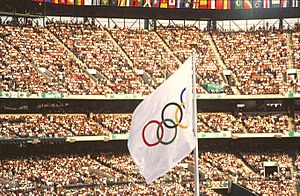
Georgia State University was used during the 1996 Summer Olympic Games. The GSU Sports Arena hosted badminton matches. The first dorms on campus were built as part of the Olympic Village to house athletes. This helped Georgia State become a large urban research university. Centennial Olympic Stadium, where the Olympics opened and closed, later became Turner Field. After the Atlanta Braves moved, Georgia State bought Turner Field in 2017. The university turned it into a football stadium, now called Center Parc Stadium. They are also building a new baseball stadium and more classrooms and housing on the site.
Marching Band
In 2010, Georgia State University started its first-ever marching band. The band performs at football games and other events. It has performed at the 2013 Second inauguration of Barack Obama, the 2014 Macy's Thanksgiving Day Parade, the 2019 Super Bowl LIII halftime show, and the 2022 Tournament of Roses Parade.
University Coat of Arms
The university's coat of arms is registered in London. Its Latin motto means, "Truth is strong and will conquer." The panther on the coat of arms holds a quill, which stands for education. The gold coin shows the university started as a business school. The flame in the center honors the first president, George Sparks. It also represents scholarship and the burning of Atlanta.
Alumni and Faculty
More than 227,000 students have graduated from Georgia State since it opened. About 100,000 alumni live in the Atlanta area today.
See also
- Cambridge University Press v. Patton, a copyright case involving GSU
- List of colleges and universities in metropolitan Atlanta


